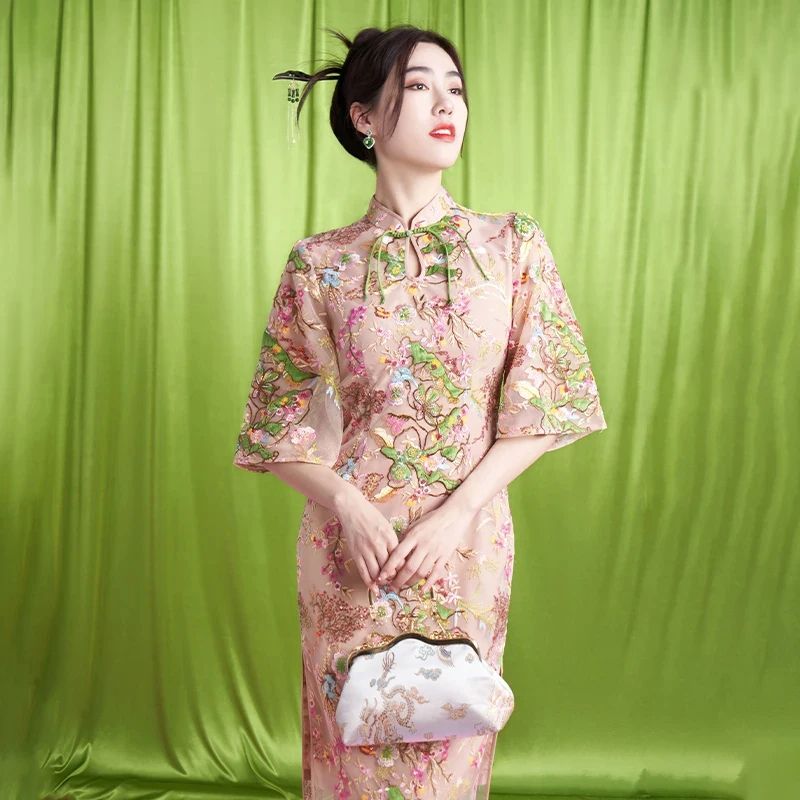Qipao Evolution: Modern Designers’ Reinterpretation of a Timeless Silhouette
The qipao, an iconic Chinese dress, has captivated fashion enthusiasts for centuries. Its timeless silhouette, characterized by a high neckline, fitted bodice, and side slits, has inspired countless designers to reinterpret this classic vêtement.

Embracing Versatility
In recent years, modern designers have embraced the qipao’s versatility, infusing it with contemporary elements while preserving its traditional essence. One notable trend is the incorporation of bold colors and prints. Designers like Guo Pei and Vivienne Tam have experimented with vibrant hues and intricate patterns, transforming the qipao into a statement piece.
Unconventional Fabrics
Another innovative approach is the use of unconventional fabrics. Traditional qipaos were typically made from silk or brocade, but designers are now exploring materials such as leather, lace, and even denim. This experimentation adds a touch of modernity to the garment while maintaining its sophistication.
Reimagined Silhouettes
Furthermore, designers are reimagining the qipao’s silhouette. Some have opted for looser fits, creating a more relaxed and comfortable version. Others have experimented with asymmetrical cuts and exaggerated sleeves, adding a touch of drama to the classic design.
Importance culturelle
The reinvention of the qipao extends beyond its physical form. Designers are also exploring its cultural significance. By incorporating traditional Chinese motifs and symbols into their designs, they pay homage to the garment’s heritage while making it relevant to contemporary society.
Conclusion
Le modern qipao is a testament to the enduring appeal of this classic garment. Through their innovative designs, contemporary designers are not only preserving the qipao’s legacy but also ensuring its continued relevance in the fashion world. Whether it’s a bold print, an unconventional fabric, or a reimagined silhouette, the qipao continues to evolve, captivating fashion enthusiasts with its timeless elegance and modern flair.
The Fusion of East and West: Qipao Styles Embracing Contemporary Aesthetics
The qipao, an iconic Chinese dress, has captivated fashion enthusiasts for centuries. Its timeless silhouette and intricate details have made it a symbol of elegance and cultural heritage. Recently, modern designers have embraced the qipao, infusing it with contemporary aesthetics to create a fusion of East and West.

Incorporating Western Tailoring
One notable trend is the incorporation of Western tailoring techniques. Designers like Vivienne Tam and Guo Pei have experimented with structured shoulders, fitted waists, and flared skirts, giving the qipao a more modern and sophisticated look. These modifications enhance the garment’s versatility, making it suitable for both formal and casual occasions.
Innovative Fabrics
Another innovation is the use of unconventional fabrics. Traditional qipaos were typically made from silk or brocade, but contemporary designers have introduced a wide range of materials, including lace, leather, and even denim. This experimentation adds a touch of edginess and modernity to the classic garment.
Modern Motifs
Furthermore, designers have played with the qipao’s traditional motifs. While the iconic dragon and phoenix embroidery remains popular, modern interpretations feature abstract patterns, geometric designs, and even pop culture references. These updates cater to the tastes of a younger generation, who seek garments that reflect their unique style.
Cultural Exploration
The fusion of East and West in qipao design is not limited to aesthetics. Designers have also explored the garment’s cultural significance. For example, some have incorporated elements of traditional Chinese painting or calligraphy into their designs, paying homage to the qipao’s heritage while embracing contemporary trends.
Conclusion
The reinvention of the qipao is a testament to the enduring appeal of this classic garment. By blending traditional elements with modern aesthetics, designers have created a new generation of qipaos that are both stylish and respectful of their cultural roots. As the qipao continues to evolve, it remains a symbol of the vibrant and ever-changing nature of fashion.
Qipao Couture: Haute Couture Meets Traditional Chinese Elegance
The qipao, an iconic Chinese garment, has captivated fashion enthusiasts for centuries. Its timeless silhouette and intricate details have inspired countless designers to reinterpret this classic piece. In recent years, modern designers have embraced the qipao, infusing it with contemporary elements while preserving its traditional essence.

Unconventional Fabric Use
One notable trend is the use of unconventional fabrics. Designers are experimenting with materials such as silk organza, lace, and even denim, creating qipaos that are both ethereal and edgy. The incorporation of sheer panels and cutouts adds a touch of modernity while maintaining the garment’s inherent elegance.
Asymmetrical Designs
Another innovation is the exploration of asymmetrical designs. Traditional qipaos typically feature a symmetrical silhouette, but modern designers are breaking away from this convention. They are creating qipaos with uneven hemlines, off-center closures, and asymmetrical sleeves, adding a touch of avant-garde flair to the classic garment.
Vibrant Colors and Patterns
Color and pattern also play a significant role in the reinvention of the qipao. Designers are moving beyond the traditional palette of red, black, and white, introducing vibrant hues and bold prints. Floral motifs, geometric patterns, and abstract designs adorn modern qipaos, creating a striking visual impact.
Contemporary Details
Furthermore, designers are incorporating contemporary details into the qipao’s construction. They are using zippers, buttons, and belts to enhance functionality and add a touch of modernity. The addition of pockets and other practical features makes the qipao more versatile and suitable for everyday wear.
Conclusion
The reinvention of the qipao is not merely a fashion statement; it is a testament to the enduring appeal of Chinese culture. Modern designers are paying homage to tradition while embracing innovation, creating garments that are both timeless and contemporary. As the qipao continues to evolve, it remains a symbol of Chinese heritage and a source of inspiration for fashion enthusiasts worldwide.
